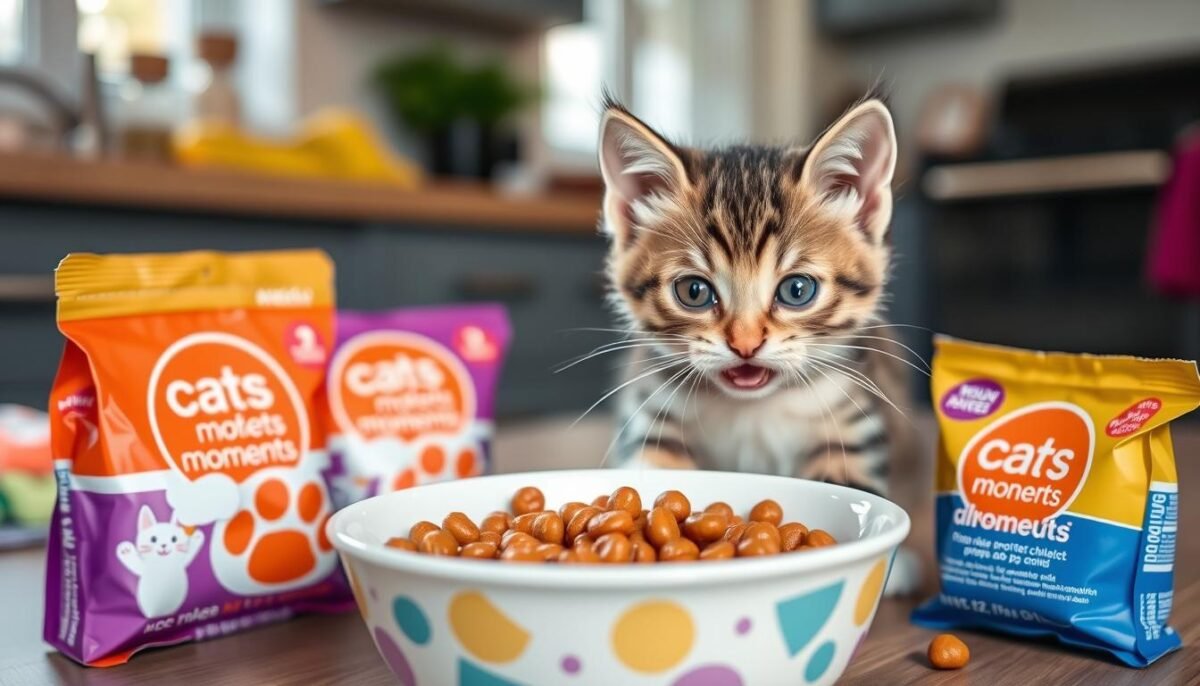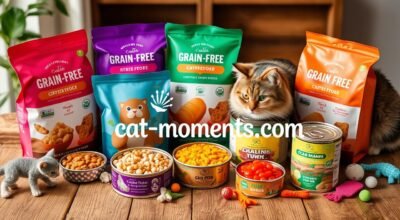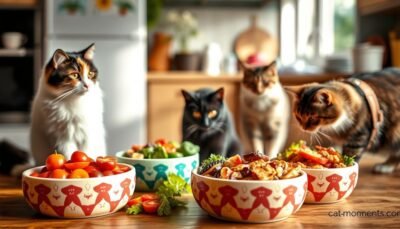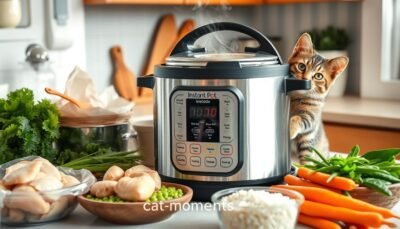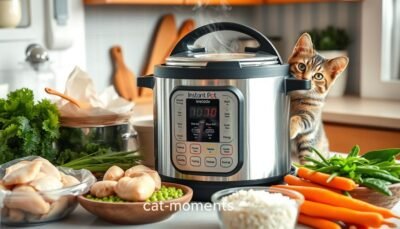As pet owners, we all want the best for our furry friends. Choosing the right wet cat food for kittens is key. But what makes some kitten wet foods better than others? In this guide, we’ll find out how to pick the best wet food for your kitten, ensuring they stay healthy in 2024 and beyond.
What makes a wet cat food the best for kittens? Is it the nutrients, the brand, or something else? Let’s explore what makes certain wet foods the top choices for our kittens.
Key Takeaways
- Discover the essential nutritional benefits of wet cat food for kittens
- Learn about the top-performing wet food brands that cater specifically to kitten needs
- Understand how to navigate the complex world of kitten nutrition and feeding guidelines
- Explore the pros and cons of homemade versus commercial wet cat food options
- Get answers to the most frequently asked questions about transitioning kittens to wet food
Why Wet Cat Food is Ideal for Kittens
Wet cat food is great for kittens because it’s full of moisture. It also meets their special needs. Kittens are always curious and growing, and wet food helps them stay healthy.
Nutritional Benefits of Wet Food
Wet cat food is packed with nutrients. It’s perfect for kittens in their growing years. These meals have high-quality proteins, vitamins, and minerals. They help kittens grow strong and keep their immune system healthy.
Enhancing Hydration in Kittens
Wet cat food has a lot of moisture. This is great for kittens because they need more water. It helps them stay hydrated and thrive.
Appeal to Fussy Eaters
Many kittens are picky eaters. Wet food’s smell and texture can make them excited to eat. Its flavors and softness make mealtime fun for even the most hesitant kittens.
Adding wet cat food to your kitten’s diet is a smart choice. It’s nutritious and helps with hydration. This approach supports their health and growth.
Key Ingredients to Look For in Wet Cat Food
Choosing the right wet cat food for your kitten is key. Kitten protein sources, kitten nutrition, and kitten food types are important. Let’s explore the main things to look for in quality wet food.
High-Quality Protein Sources
Kittens need lots of high-quality protein for growth. Look for foods with named proteins like chicken, turkey, or salmon. Avoid “meat” or “animal by-products” as they may not have all the amino acids your kitten needs.
Essential Vitamins and Minerals
Kittens also need vitamins and minerals to grow well. Foods with added taurine, vitamin E, and zinc are good. Make sure the food is complete and balanced for your kitten’s growth.
Avoiding Fillers and Artificial Additives
Stay away from foods with fillers like corn, wheat, or soy. Also, avoid artificial preservatives, colors, or flavors. Choose foods with natural, whole-food ingredients and avoid common fillers ingredients.
Focus on quality protein, essential nutrients, and avoid bad ingredients. This ensures your kitten gets the best nutrition for a healthy life. Always talk to your vet for the best food for your kitten.
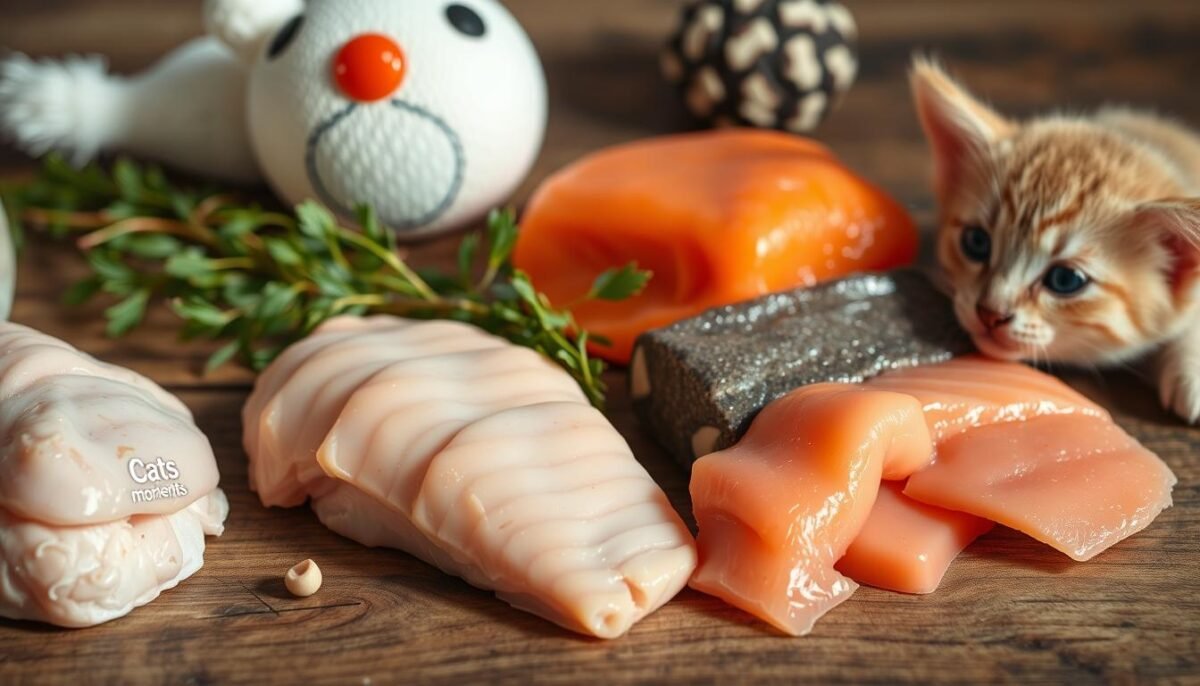
Top Wet Cat Food Brands for Kittens
Choosing the right wet cat food for your kitten is important. Several leading brands offer top-notch nutrition and quality ingredients. Let’s look at some great options for your kitten’s special needs.
Royal Canin: Specialized Nutrition
Royal Canin is a well-known name in pet food. They create formulas based on science for different life stages and health needs. Their wet cat food for kittens supports their fast growth and development.
It has high-quality proteins, vitamins, and minerals. This helps meet kittens’ unique nutritional needs.
Hill’s Science Diet: Vet-Recommended Options
Hill’s Science Diet is a vet-recommended brand. They make wet cat food specifically for kittens. Their recipes focus on balanced nutrition for growing cats.
It supports your kitten’s immune system, bone, and muscle growth. It also helps with their overall well-being.
Blue Buffalo: Natural and Wholesome Choices
Blue Buffalo is great for those who want natural and wholesome wet cat food. Their kitten-specific line has high-quality, natural ingredients. Real meat is the first ingredient in their recipes.
Blue Buffalo wet food avoids artificial preservatives, colors, and flavors. It’s a healthy choice for cat parents who care about their pet’s health.
| Brand | Protein Source | Vitamins and Minerals | Artificial Additives |
|---|---|---|---|
| Royal Canin | High-quality animal proteins | Complete and balanced | Minimal to none |
| Hill’s Science Diet | Carefully selected proteins | Tailored for kitten growth | Minimal to none |
| Blue Buffalo | Real meat as first ingredient | Natural sources of vitamins and minerals | No artificial preservatives, colors, or flavors |
These top brands offer specialized formulas and quality ingredients for kittens. They support your kitten’s growth and development. Choose the best wet food for your kitten’s needs and preferences.
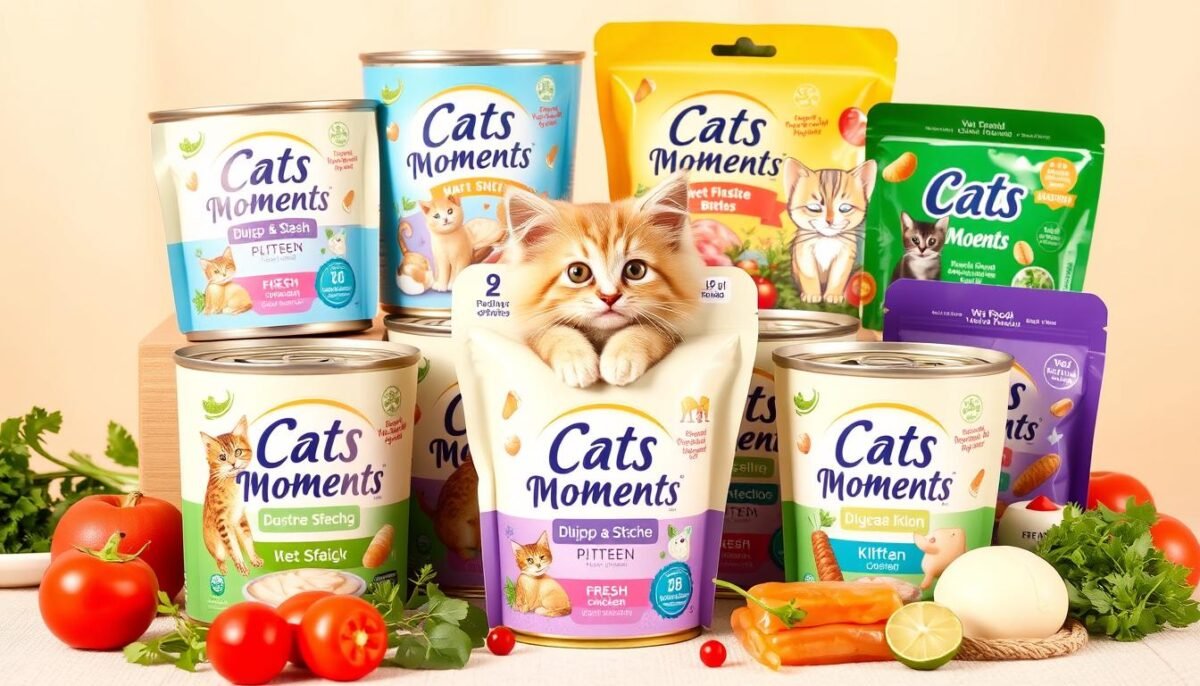
Understanding Kitten Nutritional Needs
Kittens start growing and need the right food from the start. They move from their mom’s milk to a varied diet. This change is key for their health.
Growth Stages and Dietary Requirements
Kittens grow in stages, each needing different nutrients. In the first months, they need lots of calories and protein for fast growth. As they get older, their diet needs to change to fit their growth.
Importance of Protein and Fat Content
Protein and fat are vital for kittens. Protein helps build muscles and organs. Fat gives energy and helps with vitamin absorption. A balanced diet is essential for their health.
Impact of Hydration on Development
Drinking enough water is crucial for kittens. It helps with digestion and nutrient transport. Wet food can help meet their hydration needs, supporting their growth.
| Nutrient | Importance for Kittens | Recommended Levels |
|---|---|---|
| Protein | Supports muscle, tissue, and organ growth | Minimum of 30% of diet |
| Fat | Provides concentrated energy and aids vitamin absorption | Minimum of 9% of diet |
| Hydration | Regulates body temperature, aids digestion, and transports nutrients | Wet food should make up at least 50% of their total intake |
Knowing what kittens need for nutrition, protein, and hydration helps owners. This ensures they get the right food for healthy growth.
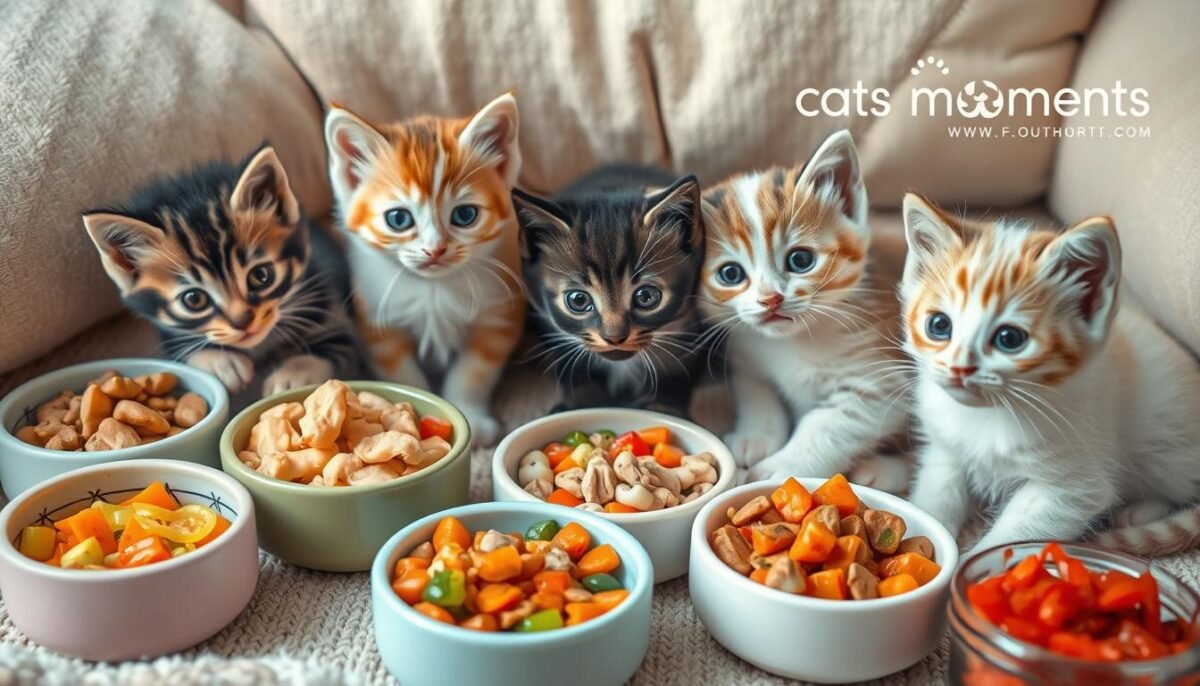
How to Transition Your Kitten to Wet Food
Switching your kitten to wet food can be easy with the right steps. Here’s a simple guide to help your kitten enjoy the benefits of wet food.
Step-by-Step Transition Process
Start by mixing a little wet food with their dry food. Slowly add more wet food over a few days. This lets your kitten get used to the new taste and texture.
Common Challenges and Solutions
Some kittens might not like the new food at first. Try warming the food to make it smell better. Or, try different flavors and textures until they find one they like. Being patient is important.
Monitoring Your Kitten’s Response
Watch how your kitten eats, their energy, and health closely. A good transition means a shiny coat, healthy weight, and lots of energy. If you see any problems, talk to your vet.
Switching to kitten wet food can make your kitten happier and healthier. With patience and the right steps, you can make the kitten feeding guide smooth for your kitten.
Best Practices for Storing Wet Cat Food
Storing wet cat food right is key to keeping it fresh and nutritious. This is especially true for kitten canned food and other wet cat food for kittens. Let’s look at the best ways to store wet cat food and keep your kitten safe.
Proper Storage Techniques
To keep wet cat food quality and safe, follow these storage tips:
- Refrigerate opened cans or pouches of wet cat food and use within 3-5 days.
- Keep unopened cans or pouches in a cool, dry place, away from direct sunlight and heat sources.
- Store wet cat food on the lower shelves of the refrigerator to prevent cross-contamination.
- Avoid storing wet cat food alongside strong-smelling foods, as it can absorb unwanted odors.
Shelf Life of Opened and Unopened Cans
The shelf life of wet cat food changes if the can or pouch is opened:
| Condition | Shelf Life |
|---|---|
| Unopened cans or pouches | Up to 2 years from the manufacturing date, when stored properly |
| Opened cans or pouches | 3-5 days when refrigerated |
Signs of Spoilage to Watch For
Watch for signs that your kitten’s wet cat food might be spoiled. Look out for these:
- Bulging or swollen cans or pouches
- Cans or pouches that are leaking or have a foul odor
- Discoloration or mold growth on the surface of the food
- Unusual texture or consistency of the wet cat food
If you see any of these signs, throw away the wet cat food. Don’t feed it to your kitten, as it might be unsafe.
By following these storage tips, you can keep your kitten safe and their meals nutritious.
Homemade vs. Commercial Wet Cat Food
Choosing between homemade and commercial wet cat food is tough. Both have good points and things to think about. Pet owners need to weigh these carefully.
Benefits of Homemade Diets
Making homemade wet cat food lets you tailor your kitten’s diet. You can pick fresh, high-quality ingredients. This way, you avoid bad additives and preservatives in some commercial foods.
Homemade meals are also flexible. They can meet your kitten’s special needs or tastes.
Risks of DIY Approaches
Homemade kitten food types are great, but they’re not without risks. Making a balanced diet for a kitten needs a lot of knowledge. Without it, you might miss important nutrients.
This could harm your kitten’s health.
Balancing Nutritional Needs Safely
Before starting homemade food, talk to a vet or pet nutritionist. They can help make a balanced recipe. They’ll also consider your kitten’s health needs.
Keep an eye on your kitten’s diet as they grow. Their needs change, and so should their food.
Choosing between homemade and commercial food is big. It needs careful thought, expert advice, and knowing your kitten’s needs. By understanding both sides, you can pick the best for your kitten’s health.
Frequently Asked Questions About Wet Cat Food
As pet parents, we often have questions about the best ways to feed our feline companions. This is especially true when it comes to the transition to wet cat food for kittens. We’ll address some of the most common queries to help ensure your kitten’s nutritional needs are met.
What Age Can Kittens Start Eating Wet Food?
Kittens can start eating wet food around 4 to 6 weeks old. This is when they wean from their mother’s milk and start eating solid foods. Wet food is great during this stage because it has high-quality protein, moisture, and essential nutrients.
How Much Wet Food Should We Feed?
- The amount of wet food for kittens depends on their age, size, and activity level. Here’s a general guideline:
- 4-12 weeks old: 2.5-5 ounces per day, divided into 3-4 meals
- 3-6 months old: 5-8 ounces per day, divided into 3 meals
- 6 months and older: 8-10 ounces per day, divided into 2-3 meals
It’s important to watch your kitten’s weight and adjust food portions as needed. This ensures they grow at a healthy pace. If you have any concerns, consult your veterinarian.
Is It Safe to Mix Wet and Dry Cat Food?
Yes, mixing wet and dry cat food is generally safe for kittens. Many experts recommend it for a balanced diet. Wet food increases moisture intake, while dry food helps with dental health. Just transition slowly and watch your kitten’s response.
| Benefits of Mixing Wet and Dry Food | Considerations When Mixing |
|---|---|
|
|
We hope these answers help you confidently introduce and maintain a healthy kitten wet food diet. Always consult your veterinarian for specific recommendations.
Conclusion: Choosing the Right Wet Cat Food for Your Kitten
Choosing the right wet cat food is key for your kitten’s health and growth. Look for high-quality protein, vitamins, and minerals. Avoid fillers and artificial additives to ensure your kitten gets the best nutrition.
Recap of Key Considerations
When picking a wet cat food, think about your kitten’s age and nutritional needs. Check the protein and fat content. Also, remember that wet food is good for hydration and can please picky eaters.
Encouraging Healthy Eating Habits
Switching to wet food can be easy with the right steps. Start by slowly introducing the new food. This helps your kitten get used to it and develop good eating habits.
Final Thoughts on Best Options
The best wet cat food for your kitten depends on their needs and your preferences. Look at brands like Royal Canin, Hill’s Science Diet, and Blue Buffalo. They offer quality wet foods for kittens. By considering these, you can find the perfect food for your kitten’s growth and health.
FAQ
What Age Can Kittens Start Eating Wet Food?
Kittens can start eating wet food as early as 4-6 weeks old. Their digestive systems are still growing. So, it’s key to introduce wet food slowly and with your vet’s advice.
How Much Wet Food Should We Feed?
The right amount of wet food for your kitten depends on their age, size, and how active they are. Feed kittens 3-4 small meals a day. Adjust the size based on their needs and the food brand’s advice.
Is It Safe to Mix Wet and Dry Cat Food?
Yes, mixing wet and dry cat food is safe for kittens. It can offer a balanced diet and meet their taste preferences. But, make sure the mix still meets their nutritional needs. Talk to your vet about the right mix.
What are the Nutritional Benefits of Wet Food for Kittens?
Wet cat food is great for kittens because it’s very moist. This helps with hydration and digestion. It’s also more tasty and packed with nutrients. These help your kitten grow fast and strong.
How Can Wet Food Help with Kitten Hydration?
Kittens need more water than adult cats because they’re smaller. Wet food helps keep them hydrated. It also helps with digestion and prevents urinary problems.
What Key Ingredients Should We Look for in Wet Cat Food?
Choose wet cat food with high-quality animal proteins like chicken, turkey, or fish. Also, look for vitamins, minerals, and healthy fats. These support your kitten’s growth and health.
How Can We Properly Transition Kittens to Wet Food?
Start transitioning kittens to wet food over 7-10 days. Mix a little wet food with their dry food at first. Slowly add more wet food. This makes the change easier and avoids upset stomachs.
How Should We Store Wet Cat Food?
Keep wet cat food fresh by storing it right. Unopened cans go in a cool, dry place. Opened cans need to be refrigerated and used in 3-5 days. Check for spoilage before feeding.
What are the Benefits and Risks of Homemade Wet Cat Food?
Homemade wet food can be tailored to your kitten’s needs. But, it’s hard to get the balance right without a vet’s help. Commercial wet food is made by experts to meet all your kitten’s needs. If you’re thinking about homemade, talk to your vet first.
